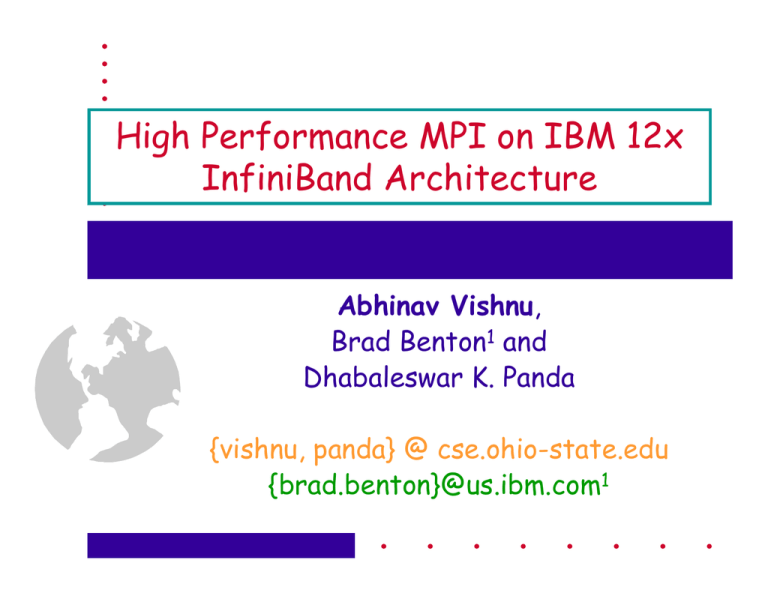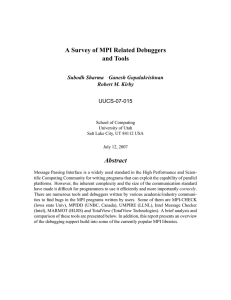High Performance MPI on IBM 12x InfiniBand Architecture Abhinav Vishnu Brad Benton
advertisement

High Performance MPI on IBM 12x
InfiniBand Architecture
Abhinav Vishnu,
Brad Benton1 and
Dhabaleswar K. Panda
{vishnu, panda} @ cse.ohio-state.edu
{brad.benton}@us.ibm.com1
1
Presentation Road-Map
• Introduction and Motivation
• Background
• Enhanced MPI design for IBM 12x
Architecture
• Performance Evaluation
• Conclusions and Future Work
2
Introduction and Motivation
• Demand for more compute power is driven by Parallel
Applications
– Molecular Dynamics (NAMD), Car Crash Simulations (LSDYNA) , ...... , ……
• Cluster sizes have been increasing forever to meet these
demands
– 9K proc. (Sandia Thunderbird, ASCI Q)
– Larger scale clusters are planned using upcoming multicore architectures
• MPI is used as the primary programming model for writing
these applications
3
Emergence of InfiniBand
• Interconnects with very low latency and very high
throughput have become available
– InfiniBand, Myrinet, Quadrics …
• InfiniBand
– High Performance and Open Standard
– Advanced Features
• PCI-Express Based InfiniBand Adapters are becoming
popular
– 8X (1X ~ 2.5 Gbps) with Double Data Rate (DDR) support
– MPI Designs for these Adapters are emerging
• Compared to PCI-Express, GX+ I/O Bus Based Adapters are
also emerging
– 4X and 12X link support
4
InfiniBand Adapters
To Host
To Network
12x
4x
HCA
HCA
Chipset
Chipset
P1
P1
P2
P2
4x
12x
I/O
I/OBus
BusInterface
Interface
PCI-XBidirectional
(4x(16x
Bidirectional)
PCI-Express
Bidirectional)
GX+
(>24x
Bandwidth) (SDR/DDR)
MPI for PCI-Express based are coming up
IBM 12x InfiniBand Adapters on GX+ are coming up
5
Problem Statement
• How do we design an MPI with low overhead for
IBM 12x InfiniBand Architecture?
• What are the performance benefits of enhanced
design over the existing designs?
– Point-to-point communication
– Collective communication
– MPI Applications
6
Presentation Road-Map
• Introduction and Motivation
• Background
• Enhanced MPI design for IBM 12x
Architecture
• Performance Evaluation
• Conclusions and Future Work
7
Overview of InfiniBand
• An interconnect technology to connect I/O nodes and
processing nodes
• InfiniBand provides multiple transport semantics
– Reliable Connection
• Supports reliable notification and Remote Direct Memory
Access (RDMA) 9
– Unreliable Datagram
• Data delivery is not reliable, send/recv is supported
– Reliable Datagram
• Currently not implemented by Vendors
– Unreliable Connection
• Notification is not supported
• InfiniBand uses a queue pair (QP) model for data transfer
– Send queue (for send operations)
– Receive queue (not involved in RDMA kind of operations)
8
MultiPathing Configurations
A combination of these is also possible
Switch
Switch
Multiple Adapters
and Multiple Ports
(Multi-Rail Configurations)
Multi-rail for multiple
Send/recv engines
9
Presentation Road-Map
• Introduction and Motivation
• Background
• Enhanced MPI design for IBM 12x
Architecture
• Performance Evaluation
• Conclusions and Future Work
10
MPI Design for 12x Architecture
Communication Marker
pt-to-pt,
collective?
ADI Layer
Eager, Rendezvous
Communication
Scheduler
EPC
Scheduling
Policies
Multiple QPs/port
Completion
Notifier
Notification
InfiniBand Layer
Jiuxing Liu, Abhinav Vishnu and Dhabaleswar K. Panda. , “
Building Multi-rail InfiniBand Clusters:
MPI-level Design and Performance Evaluation, ”. SuperComputing 2004
11
Discussion on Scheduling Policies
Enhanced Pt-to-Pt and Collective (EPC)
Non-blocking
Policies
Reverse
Multiplexing
9
Binding
Blocking
Communication
Collective
Communication
Round
Robin
Even Striping
Overhead
•Multiple Stripes
•Multiple Completions
12
EPC Characteristics
pt-2-pt
collective
blocking
striping
non-blocking
round-robin
striping
• For small messages, round robin policy is used
– Striping leads to overhead for small messages
13
MVAPICH/MVAPICH2
• We have used MVAPICH as our MPI framework
for the enhanced design
• MVAPICH/MVAPICH2
– High Performance MPI-1/MPI-2 implementation over
InfiniBand and iWARP
– Has powered many supercomputers in TOP500
supercomputing rankings
– Currently being used by more than 450 organizations
(academia and industry worldwide)
– http://nowlab.cse.ohio-state.edu/projects/mpi-iba
• The enhanced design is available with MVAPICH
– Will become available with MVAPICH2 in the upcoming
releases
14
Presentation Road-Map
• Introduction and Motivation
• Background
• Enhanced MPI design for IBM 12x
Architecture
• Performance Evaluation
• Conclusions and Future Work
15
Experimental TestBed
• The Experimental Test-Bed consists of:
–
–
–
–
–
Power5 based systems with SLES9 SP2
GX+ at 950 MHz clock speed
2.6.9 Kernel Version
2.8 GHz Processor with 8 GB of Memory
TS120 switch for connecting the adapters
• One port per adapter and one adapter is used for
communication
– The objective is to see the benefit with using only one
physical port
16
Ping-Pong Latency Test
• EPC adds insignificant overhead to the small message latency
• Large Message latency reduces by 41% using EPC with IBM
12x architecture
17
Small Messages Throughput
• Unidirectional bandwidth doubles for small messages using
EPC
• Bidirectional bandwidth does not improve with increasing
number of QPs due to the copy bandwidth limitation
18
Large Messages Throughput
• EPC improves the uni-directional and bi-directional
throughput significantly for medium size messages
• We can achieve a peak unidirectional bandwidth of 2731
MB/s and bidirectional bandwidth of 5421 MB/s
19
Collective Communication
• MPI_Alltoall shows significant benefits for large messages
• MPI_Bcast shows more benefits for very large messages
20
NAS Parallel Benchmarks
• For class A and class B problem sizes, x1 configuration shows
improvement
• There is no degradation for other configurations on Fourier
Transform
21
NAS Parallel Benchmarks
• Integer sort shows 7-11% improvement for x1 configurations
• Other NAS Parallel Benchmarks do not show performance
degradation
22
Presentation Road-Map
• Introduction and Motivation
• Background
• Enhanced MPI design for IBM 12x
Architecture
• Performance Evaluation
• Conclusions and Future Work
23
Conclusions
• We presented an enhanced design for IBM 12x InfiniBand
Architecture
– EPC (Enhanced Point-to-Point and collective
communication)
• We have implemented our design and evaluated with Microbenchmarks, collectives and MPI application kernels
• IBM 12x HCAs can significantly improve communication
performance
– 41% for ping-pong latency test
– 63-65% for uni-directional and bi-directional bandwidth
tests
– 7-13% improvement in performance for NAS Parallel
Benchmarks
– We can achieve a peak bandwidth of 2731 MB/s and 5421
MB/s unidirectional and bidirectional bandwidth
respectively
24
Future Directions
• We plan to evaluate EPC with multi-rail
configurations on upcoming multi-core systems
– Multi-port configurations
– Multi-HCA configurations
• Scalability studies of using multiple QPs on large
scale clusters
– Impact of QP caching
– Network Fault Tolerance
25
Acknowledgements
Our research is supported by the following organizations
• Current Funding support by
• Current Equipment support by
26
Web Pointers
http://nowlab.cse.ohio-state.edu/
MVAPICH Web Page
http://mvapich.cse.ohio-state.edu
E-mail: {vishnu, panda}@cse.ohio-state.edu,
brad.benton@us.ibm.com
27




